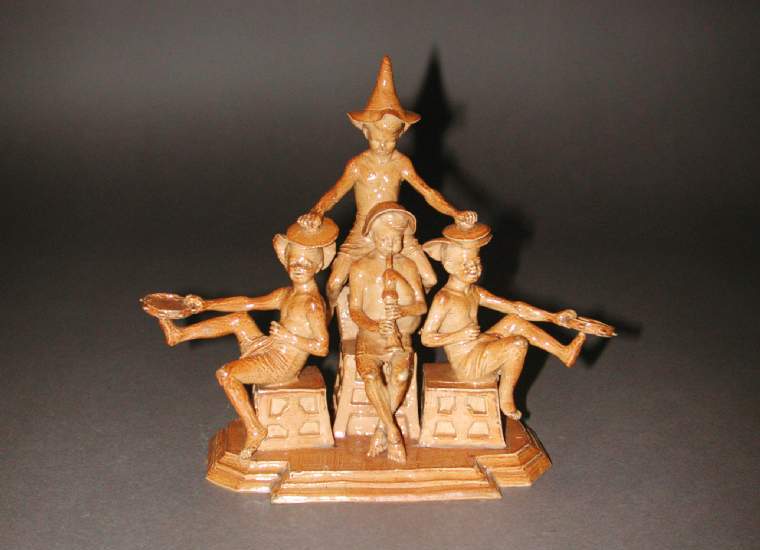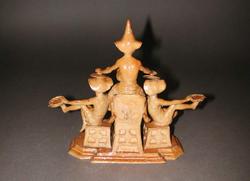Current Location: Gallery 27 (Glaisher)
Titles
Group of Boy Musicians
Maker(s)
Pottery:
Doulton & Co.
Modeller:
Tinworth, George
Entities
Categories
Description
Salt-glazed stoneware figure group of four musicians.
The group is partly moulded and partly hand modelled from stoneware, painted with a buff coloured slip and salt-glazed. The four boy musicians wear only loin cloths and caps. Three sit on chairs; two of them are back to back with a tambourine in one hand which he is kicking with his outstretched foot; the other is in the middle, facing forward and playing the bagpipes. The fourth musician sits above the others, on the back of the middle chair; he wears a pointed hat and holds a cymbal in each hand, resting or banging them on the side musicians’ flat caps. The base is 16-sided, but roughly oblong in shape. The underside is flat with three round vent holes, one under each chair.
Notes
History note: Mr Morrall [or Monsall?] of 48 Liverpool Street, Stoke on Trent. Bought on 10 March 1928 for £4 and ten shillings, by Dr Glaisher, Trinity College, Cambridge.
Legal notes
Dr J.W.L. Glaisher Bequest
Measurements and weight
Height: 16.8 cm
Height: 6.5 in
Width: 20 cm
Width: 6.625 in
Acquisition and important dates
Method of acquisition: Bequeathed
(1928)
by
Glaisher, J. W. L., Dr
Dating
19th Century, Late
Victorian
Circa
1885
CE
-
1890
CE
Note
Doulton and Co, founded c.1815, originally made utility ceramics, with some stoneware jugs and bottles. In the mid 1860s, Henry Doulton introduced decorative stoneware and architectural terracotta and, over the next 50 years, employed some 400 artists, many of them Lambeth School of Art students. Doulton championed individuality, innovation and versatility, and his modellers and decorators used a wide range of techniques and decorative treatments in producing both unique, artist-signed, and limited edition pieces. From 1872 the business expanded into faience and in the 1880s opened a factory at Burslem, Staffordshire, where bone china and other wares were made. In 1901, Edward VII granted the Royal warrant to the factory. Stoneware production at Lambeth reduced after 1914, and ceased in 1956.
George Tinworth (1843-1913 ) worked for his father, a wheelwright, whilst he studied modelling at Lambeth School of Art and the Royal Academy. He worked at Doulton & Co from 1866-1913, where he lead the introduction of decorative salt-glazed stoneware. His most important commissions were terracotta relief panels, of which he made some 500, including a reredos at York Minster and work for the Guards Chapel.
This group is related to a series of boy musicians, playing over 35 instruments, which Tinworth made between 1889-1912. He also made anthropomorphic mice and frogs; and similar studies set around salt-cellars. The Doulton mark on the base indicates it was made before 1891.
School or Style
Art Pottery
People, subjects and objects depicted
Components of the work
Part
Materials used in production
Salt-glaze
Stoneware
Techniques used in production
Painting
Salt-glazing
Inscription or legends present
Inscription present: rectangular seal with 'DOULTON LAMBETH'
- Text: DOULTON LAMBETH
- Location: Underside of base
- Method of creation: Impressed
- Type: Mark
Inscription present: GT in monogram
- Text: GT
- Location: On back of model
- Method of creation: Incised
- Type: Monogram
Inscription present: rectangular paper label
- Text: 4985 Brown Doulton group of four musicians by George Tinworth b. March 10 1928, came from Stoke on Trent.
- Location: Underside of base
- Method of creation: Handwritten in black ink
- Type: Label
References and bibliographic entries
Identification numbers
Accession number: C.1222-1928
Primary reference Number: 71619
Old object number: 4985
Stable URI
Audit data
Created: Saturday 6 August 2011
Updated: Tuesday 30 April 2024
Last processed: Tuesday 15 July 2025
Associated departments & institutions
Owner or interested party:
The Fitzwilliam Museum
Associated department:
Applied Arts





